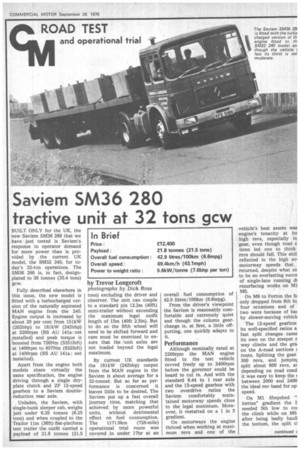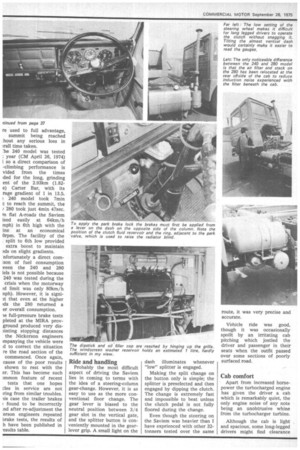Saviem 5M36 280 tractive unit at 32 tons gcw
Page 39

Page 40

Page 41

If you've noticed an error in this article please click here to report it so we can fix it.
BUILT ONLY for the UK, the new Saviem SM36 280 that we have just tested is Saviem's response to operator demand for more power than is provided by the current UK model, the SM32 240, for today's 32-ton operations. The SM36 280 is, in fact, designplated to 36 tonnes (35.4 tons) gcw.
Fully described elsewhere in this issue, the new model is fitted with a turbocharged version of the naturally aspirated MAN engine from the 240. Engine output is increased by about 20 per cent from 151kW (202bhp) to 181kW (242bhp) at 2200rpm (BS AU 141a: net installed) and peak torque is boosted from 726Nm (5351 lbft) at 1400rpm to 857Nm (6321bft) at 1400rpm (BS AU 141a: net installed).
Apart from the engine both models share virtually the same specification, the engine driving through a single dryplate clutch and ZF 12-speed gearbox to a Saviem doublereduction rear axle.
Unladen, the Saviem, with single-bunk sleeper cab, weighs just under 6.35 tonnes (6.25 tons) and when coupled to the Trailor Ilm (36ft) flat-platform test trailer the outfit carried a payload of 21.8 tonnes (21.5
by Trevor Longcroft
photographs by Dich Ross tons) excluding the driver and observer. The unit can couple to a standard pin 12.2m (40ft) semi-trailer without exceeding the maximum legal outfit length of 15m (49ft 2.5in). But to do so the fifth wheel will need to be shifted forward and care must be exercised to ensure that the 'unit axles are not loaded beyond the legal maximum.
By current UK standards the 181kW (2421thp) output from the MAN engine in the Saviem is about average for a 32-tonner. But so far as performance is concerned it leaves little to be desired. The Saviem put up a fast overall journey time, matching that achieved by more powerful units, without detrimental effect on fuel consumption.
The 1171.9km (728-mile) operational trial route was covered in under 17hr at an overall fuel consumption of 42.9 litres/100km (6.6mpg).
From the driver's viewpoint the Saviem is reasonably comfortable and extremely quiet and though the column gearchange is, at first, a little offputting, one quickly adapts to It.
Performance
Although nominally rated at 2200rpm the MAN engine fitted to the test vehicle revved freely up to 2400rpm before the governor could be heard to cut in. And with the standard 6.44 to 1 rear axle and the I2-speed gearbox with two overdrive ratios the Saviem comfortably maintained motorway speeds close to the legal maximum. Moreover, it restarted on a 1 in 5 gradient.
On motorways the engine thrived when working at maximum revs and one of the vehicle's best assets was engine's tenacity at ho high revs, especially in gear, even though road c tions led one to think revs should fall. This abil reflected in the high all., motorway speeds that returned, despite what se to be an everlasting succe of single-lane running di resurfacing works on MI M6, On M6 to Forton the Sz only dropped from 6th hi, four occasions and of two were because of bat by slower-moving vehich The 12-speed gearbox its well-specified ratios a fast split changes came its own on the steeper r way climbs and the gra, on the A-road sections ( route. Splitting the gear 300 revs, ,and jumpinl split about 600 revs, ar depending on road cond it was easy to keep the between 2000 and 2400 the ideal rev band for op speed.
On MI Shepshed " lorries" gradient the needed 5th low to coi the climb while on M6 after being badly baull the bottom, the split cl re used to full advantage, summit being reached .hout any serious loss in !rail time taken.
'he 240 model was tested : year (CM April 26, 1974) I so a direct comparison of -climbing performance is vided from the times ded for the long, grinding ent of the 2.93km (1.82e) Carter Bar, with its rage gradient of 1 in 13.5.
240 model took 7min c to reach the summit, the r 280 took just 4min 47sec. In flat A-roads the Saviem ised easily at 64km/h mph) in 6th high with the Me at an economical Orpm. The facility of the . split to 6th low provided extra boost to maintain mls on slight gradients.
nfortunately a direct cornson of fuel consumption veen the 240 and 280 Eels is not possible because 240 was tested during the crisis when the motorway KI limit was only 80km/h nph). However, it is signiit that even at the higher mls the 280 returned a er overall consumption.
le full-pressure brake tests pleted at the MIRA provground produced very dis)inting stopping distances the Nickerson engineers Impanying the vehicle were d to correct the situation re the road section of the commenced. Once again, cause of the poor results shown to rest with the er. This has become such )mmon feature of recent tests that one hopes cles in service are not ring from similar troubles. is case the trailer brakes found to be incorrectly .nd after re-adjustment the erson engineers repeated brake tests, the results of h have been published in 'esults table.
Ride and handling
Probably the most difficult aspect of driving the Saviem lies in coming to terms with the idea of a steering-column gear-change. However, it is as easy to use as the more conventional floor change. The gear lever is biased to the neutral position between 3/4 gear slot in the vertical gate, and the splitter button is conveniently mounted in the gearlever grip. A small light on the dash illuminates whenever "low" splitter is engaged.
Making the split change on the button only is simple; the splitter is preselected and then engaged by dipping the clutch. The change is extremely fast and impossible to beat unless the clutch pedal is not fully floored during the change.
Even though the steering on the Saviem was heavier than I have exprienced with other 32tanners tested over the same route, it was very precise and accurate.
Vehicle ride was good, though it was occasionally spoilt by an irritating cab pitching which jostled the driver and passenger in their seats when the outfit passed over some sections of poorly surfaced road.
Cab comfort
Apart from increased horsepower the turbocharged engine has given the driver a cab which is remarkably quiet, the only engine noise of any note being an unobtrusive whine from the turbocharger turbine.
Although the cab is light and spacious, some long-legged drivers might find clearance beneath the steering wheel restricted. I am nearly 6ft tall and found it difficult to settle into an ideal driving position: I could not raise the seat sufficiently high without my left thigh snagging the steering wheel whenever I used the clutch. I managed to get an acceptable position by moving the seat further back than I would normally like, though it was irksome to have to twist my leg •to avoid hitting the steering wheel whenever I used the clutch.
The Saviem is specified with lock actuators which are applied by one lever and locked into the park position by another, the levers being located on the dash at either side of the steering column Apart from the danger of drivers not bothering, or forgetting, to lock the brakes it would be more convenient if bath functions could be incorporated into one control which could be sited within more comfortable driver reach. I understand that spring brakes are likely to be specified on this vehicle in the near future.
Summarising, the Saviem SM36 280, based on its test performance, stands up well against the competition. It offers an acceptable fuel consumption and excellent journey times. In the wellfitted cab there is still room for a rather more ergonomic approach to the layout of frequently-used controls, but it is quiet and spacious.
As tested, the Saviem SM36 280 with sleeper cab costs £12,400 excluding fifth-wheel.




































































































